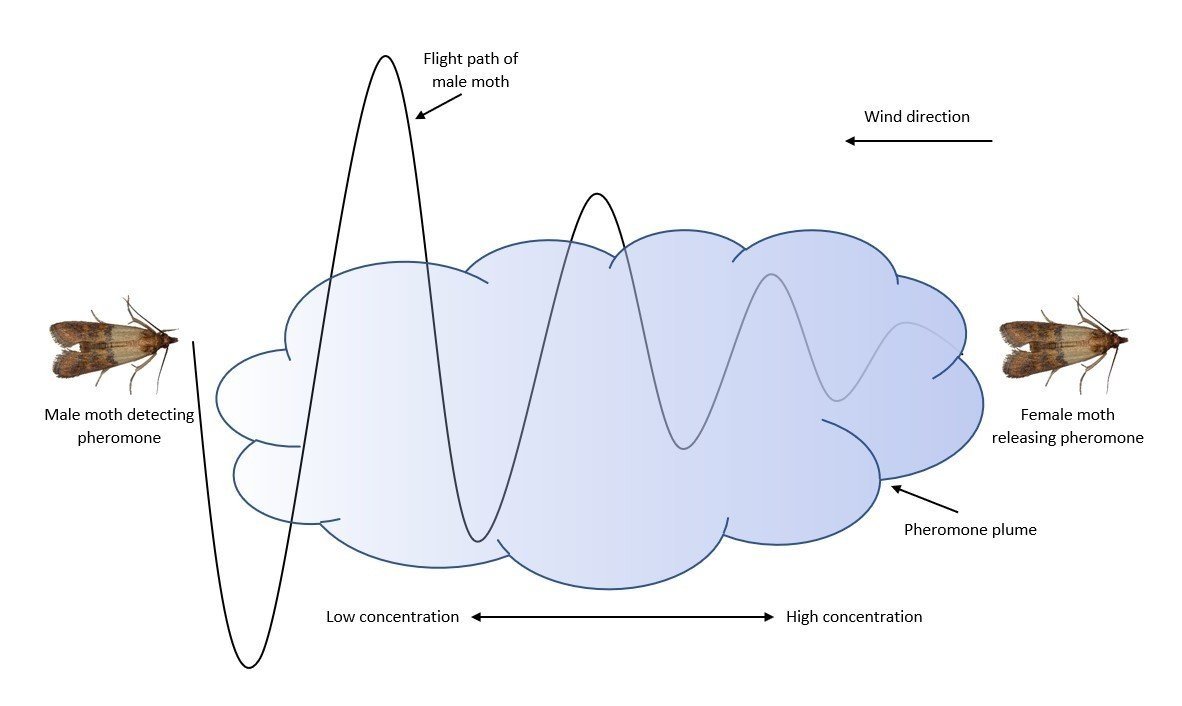What Are Pheromones?
By Ethan Estabrook, BCE
Pheromones are chemicals that are released by insects that stimulate a behavioral change to other insects of the same species.
This form of chemical communication is used by insects to direct social behavior - including mate attraction, gathering together, egg-laying, foraging for food, trail following, and colony defense
Many stored product insects communicate with volatile or airborne pheromones that travel through the air.
As one of these insects emits pheromone, it creates a pheromone plume that spreads out and decreases in concentration the further away from the emitting insect.
Other insects who are attracted to this pheromone, detect the plume, and move upwind towards higher pheromone concentration until it reaches the emitting insect.
While there are many types of pheromones, two are commonly used as lures to monitor stored product and other urban insects: sex pheromones and aggregation pheromones.
Sex pheromones are produced by females to attract males for mating. Usually, adult insect species with short life spans of only a few weeks produce sex pheromones. Some examples include the Indian meal moth, webbing clothes moth, and cigarette beetle. Adult males with a short life span are highly attracted to sex pheromones due to their determination to find a female to mate with before they die. Male insects can be so sensitive to these sex pheromones that only a few nanograms, which is 1 billionth of a gram, can cause males to search for a female. These pheromones can be active over distances of several hundred feet and in some cases, like the gypsy moth, even miles away.
Aggregation pheromones are typically produced by males to attract BOTH male and females to a favorable location, usually near a food source. Aggregation pheromones can be thought of as the party pheromone. This gathering of insects increases the likelihood of mating and identifies a favorable location where females can lay eggs on food material. Aggregation pheromones are usually produced in species with long adult life spans of several months to years, such as red and confused flour beetles, rice weevils, and lesser grain borers. The attraction distance of aggregation pheromones is much shorter than sex pheromones. In many cases, food odors are used to synergize the attraction effect of aggregation pheromones.
Pheromones are part of a greater chemical communication family called semiochemicals which include kairomones and allomones. Kairomones and allomones are interspecific chemical communication between DIFFERENT species. Kairomones benefit the receiver which can be insects following food scents to find food, or host/prey interactions like a female parasitic wasp finding a caterpillar to lay eggs in. Allomones benefit the emitter which can be defense secretions of ants protecting their nest or repellents to ward off competing species.
Ethan Estabrook of Insects Limited studies the insects on a glue to trap identify the species
In a study from Haskins et al., they describe a unique example of how these different chemical communication classes interact with carpenter ants. Carpenter ants produce and spray formic acid which excites other members of the carpenter ant colony and acts as a call to arms to defend the nest. Formic acid in this interaction can be categorized as an alarm pheromone. Carpenter ants also use formic acid to help protect themselves from predators and to help subdue prey. Formic acid in this interaction benefits the carpenter ant and can be categorized as an allomone. The same chemical also attracts Australian bulldog ants who use formic acid to find and predate on carpenter ants. Formic acid in this interaction benefits the receiver and can be categorized as a kairomone. In this real-world scenario, the same semiochemical, Formic acid, can be categorized as a pheromone, allomone, or kairomone depending on the perspective of who benefits from this particular chemical communication.
References
Haskins, C.P., Hewitt, R.E. and Haskins, F. (1973) Release of aggressive and capture behaviour in the ant Myrmecia gulosa F. by exocrine products of the ant Camponotus. J. Ent. (A), 47, 125-139
Howse, P. E., & R., S. I. D. (1998). Insect pheromones and their use in Pest Management. Chapman & Hall.
Insects Limited, an Insect Pheromone Company
Insects Limited, Inc. researches, tests, develops, manufactures and distributes pheromones and trapping systems for insects in a global marketplace. The highly qualified staff also can assist with consultation, areas of expert witness, training presentations and grant writing.
Insects Limited, Inc. specializes in a unique niche of pest control that provides mainstream products and services to protect stored food, grain, museum collections, tobacco, timber and fiber worldwide. Please take some time to view these products and services in our web store.


